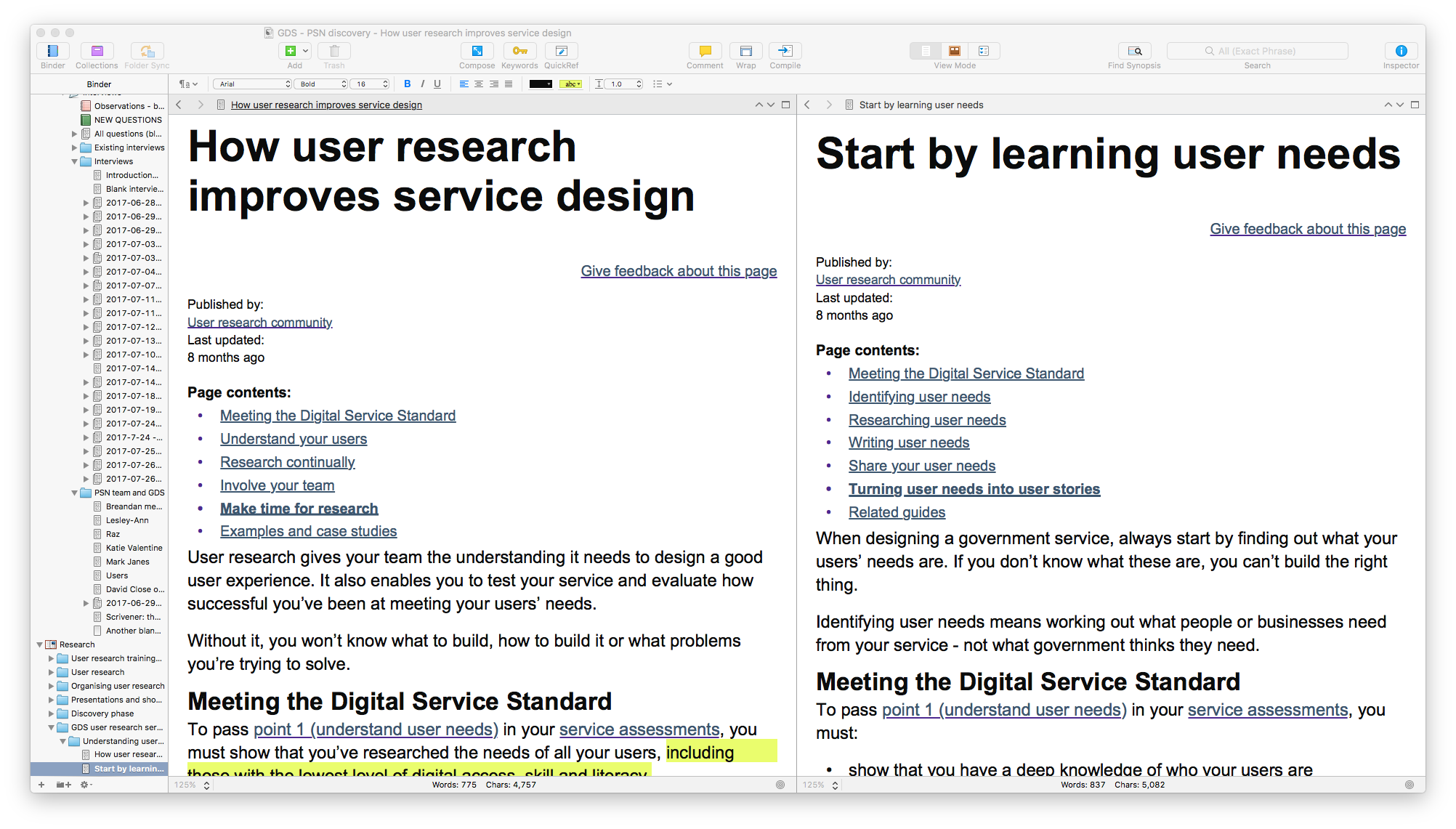User research involves a lot of, well, research; a lot of notes, documents, videos, pictures, post its and more. And they all need organising.
There’s no one solution for the problem of what to do with all this, but after a bit of experimentation I find that using Scrivener has been the best for me for keeping things organised.
Scrivener is often seen as a writing tool, but it’s more than a word processor. Yes, it is a writing tool – from word processing to screenplays – but it is also an organiser. Most important it’s very simple to use, and has more advance features for those who want them.

Renaming research in Scrivener
I’ve been using Scrivener for years, and coming from an anthropological and journalist background to user research I focus research that’s written up – observations, interviews, transcripts. But I also add photos, plan card sorts, organise thoughts with the card index display, and add spreadsheets, PDFs and presentations. Even if I don’t read the presentations directly in there, being able to search all relevant work in one search helps.
In Scrivener I like how easy it is to organise and rename documents, or duplicate them. Compared with doing this in Finder or Explorer, it is much less of a faff. Likewise documents open immediately rather than take a few seconds in Word or Google Drive (and often aren’t the one I want anyway).
While I still use Google Drive and Dropbox and to organise files, particularly video, due to the amount of research that is pure words, either as transcripts, proposals, documents or insights, I find that Scrivener is the best way to keep it all together.
Tables
I love tables. I like maths, I like spreadsheets. Really.
I like to organise interview questions in tables and use a Dewey-esque numbering system to help reorganise them. So question 101 is the first, but perhaps it needs to come later, so I reorganise it as 103 and sort.
Likewise when reviewing a transcript I like to have each question in its own cell with thoughts and insights in the cell next to it.
Scrivener could be friendlier with tables – don’t create one at the end of a page or you’ll never get out, and I always have to customise it. But once I created a good, blank table I could copy and paste that.
| Sort code | Quote | Observation |
|---|---|---|
| 101 | I’m not really sure that it’s appropriate | User not keen on this |
| 102 | Do I really have to give you a dummy quote? | Prefers to be in control of speech |
| 250 | At this time, a friend shall lose his friend’s hammer and the young shall not know where lieth the things possessed by their fathers | Likes Brian? |
Good things about using Scrivener for user research
What’s great:
- Easy to move documents around and organise into folders and rename them
- Split view makes reviewing transcripts and images easy
- Colour and icon coding makes it easy to find key files
- Compiling documents means you can make it consistent output, or just select the ones you need to put into a single PDF or Word report, or output as multiple documents so you don’t have to worry about formatting until the end
- Coding for things such as image captions means that you don’t have problems with Word getting confused about auto-numbers
- Text file syncing – if out in the field you can create text notes and sync them automatically into the project
- Great search tool for searching titles or entire files
- Corkboard views to organise thoughts, observations, insights etc
- Good way to have a list of priorities and hierarchies
- Importing documents automatically works pretty well, just drag and drop the Word docs to where you want them and it’ll convert them into a continuous webpage rather than multi page report
What’s not so great:
- No dictation tool
- Not always the best way to view documents and tables
- No Android version, although there is one for iOS, although it’s rare that you need the entire project on ⁃ your phone
- Adding weblink – it already fills in the https:// part but every time you copy and paste from Chrome it has that part, so you get ‘broken’ links as it’s https://https:// if you forget to remove that part
- Can be fiddly with bullets
User research tools to support Scrivener
OneNote, which isn’t free, is good for:
- Transcripts – jump to the audio where your notes are as it tracks your writing with recording (although only 15min recording on Android for some unknown reason). It can convert speech to text, though I find that’s a bit less reliable.
- Optical character recognition – it’s not 100% accurate but it’s good enough for recognising text from images and these will be show in search
- Syncs across devices
I also use Trello to track research questions, answers and insights.
Overall Scrivener with its files synced through the cloud (Dropbox, OneDrive etc) has been great for keeping track of research. Scrivener isn’t free, but I feel I got my $45 worth of use long ago, and it’s less than what Microsoft charges for Office 365 (which includes OneNote).
Scrivener hasn’t sponsored or otherwise provided incentives for me to write this (nor has Microsoft, though I’d feel weird if they did), I just want to spread the word for a useful tool.
